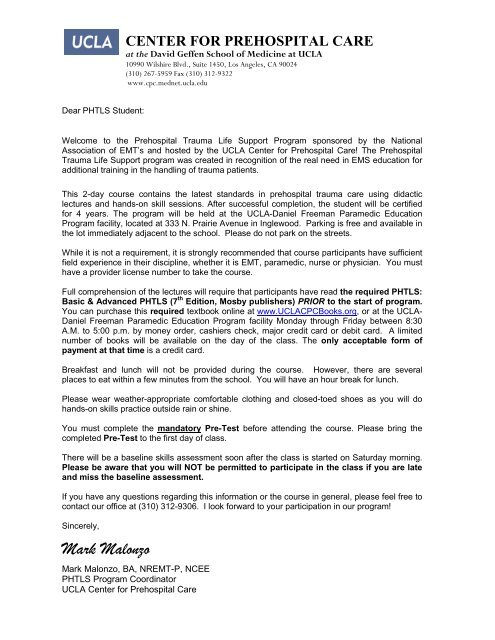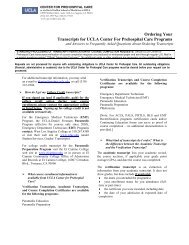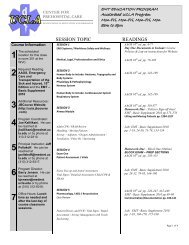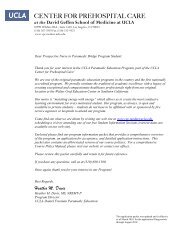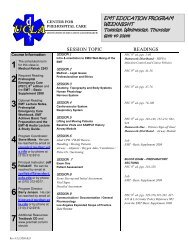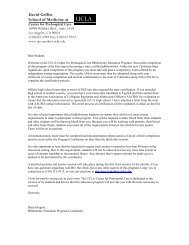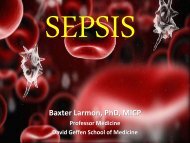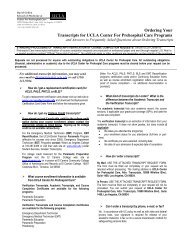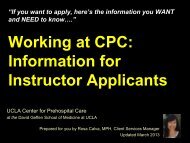Mark Malonzo - UCLA Center for Prehospital Care
Mark Malonzo - UCLA Center for Prehospital Care
Mark Malonzo - UCLA Center for Prehospital Care
Create successful ePaper yourself
Turn your PDF publications into a flip-book with our unique Google optimized e-Paper software.
CENTER FOR PREHOSPITAL CAREat the David Geffen School of Medicine at <strong>UCLA</strong>10990 Wilshire Blvd., Suite 1450, Los Angeles, CA 90024(310) 267-5959 Fax (310) 312-9322www.cpc.mednet.ucla.eduDear PHTLS Student:Welcome to the <strong>Prehospital</strong> Trauma Life Support Program sponsored by the NationalAssociation of EMT’s and hosted by the <strong>UCLA</strong> <strong>Center</strong> <strong>for</strong> <strong>Prehospital</strong> <strong>Care</strong>! The <strong>Prehospital</strong>Trauma Life Support program was created in recognition of the real need in EMS education <strong>for</strong>additional training in the handling of trauma patients.This 2-day course contains the latest standards in prehospital trauma care using didacticlectures and hands-on skill sessions. After successful completion, the student will be certified<strong>for</strong> 4 years. The program will be held at the <strong>UCLA</strong>-Daniel Freeman Paramedic EducationProgram facility, located at 333 N. Prairie Avenue in Inglewood. Parking is free and available inthe lot immediately adjacent to the school. Please do not park on the streets.While it is not a requirement, it is strongly recommended that course participants have sufficientfield experience in their discipline, whether it is EMT, paramedic, nurse or physician. You musthave a provider license number to take the course.Full comprehension of the lectures will require that participants have read the required PHTLS:Basic & Advanced PHTLS (7 th Edition, Mosby publishers) PRIOR to the start of program.You can purchase this required textbook online at www.<strong>UCLA</strong>CPCBooks.org, or at the <strong>UCLA</strong>-Daniel Freeman Paramedic Education Program facility Monday through Friday between 8:30A.M. to 5:00 p.m. by money order, cashiers check, major credit card or debit card. A limitednumber of books will be available on the day of the class. The only acceptable <strong>for</strong>m ofpayment at that time is a credit card.Breakfast and lunch will not be provided during the course. However, there are severalplaces to eat within a few minutes from the school. You will have an hour break <strong>for</strong> lunch.Please wear weather-appropriate com<strong>for</strong>table clothing and closed-toed shoes as you will dohands-on skills practice outside rain or shine.You must complete the mandatory Pre-Test be<strong>for</strong>e attending the course. Please bring thecompleted Pre-Test to the first day of class.There will be a baseline skills assessment soon after the class is started on Saturday morning.Please be aware that you will NOT be permitted to participate in the class if you are lateand miss the baseline assessment.If you have any questions regarding this in<strong>for</strong>mation or the course in general, please feel free tocontact our office at (310) 312-9306. I look <strong>for</strong>ward to your participation in our program!Sincerely,<strong>Mark</strong> <strong>Malonzo</strong><strong>Mark</strong> <strong>Malonzo</strong>, BA, NREMT-P, NCEEPHTLS Program Coordinator<strong>UCLA</strong> <strong>Center</strong> <strong>for</strong> <strong>Prehospital</strong> <strong>Care</strong>
PHTLS7 th EditionPre-TestPre-TestVersion 1.3
Instructions to CandidatesThis 25-question exam is designed to assess yourbase knowledge of trauma care. It is written <strong>for</strong> alllevels of EMTs and prehospital providers. There aresome questions that the correct answer may be anadvanced procedure that the basic-level provider isunable to per<strong>for</strong>m due to system protocols or traininglevels. It is assumed that any provider who is takingthe PHTLS course, regardless of level of training,will understand and recognize the need <strong>for</strong> an ALSprocedure, even if they are not authorized to do so..To this end, the basic provider should select the ALSanswer if appropriate and not deem it incorrectbecause the procedure cannot be per<strong>for</strong>med by abasic provider.Version 1.3 1
1) Your EMS unit is en route to the scene of an assault. Dispatch in<strong>for</strong>mationindicates law en<strong>for</strong>cement has not yet arrived on the scene. The safest approach tothis situation is:A) Staging at the scene so that you can advise dispatch of the nature of thepatient’s injuriesB) Arriving on scene but staying inside the vehicle until law en<strong>for</strong>cement advisesthe scene is safeC) Staging at a safe location away from the scene until law en<strong>for</strong>cement advisesthe scene is safeD) Arriving on scene and initiating care, as long as bystanders confirm theassailant is no longer there2) Which is a sign of ventilatory inadequacy in a trauma patient?A) Equal breath soundsB) Ventilatory rate of 12C) Speaking in short burstsD) Sp0 2 of 95% on room air3) During the primary survey of a trauma patient, you note that the patient is agitatedand confused and appears to have multiple injuries from an altercation. Of thefollowing choices, your first treatment priority should be:A) Controlling all bleedingB) Establishing an intravenous lineC) Correction of possible hypoxiaD) Full immobilization to a backboard4) Which is the most common cause of upper airway obstruction in the traumapatient?A) TeethB) BloodC) TongueD) Vomitus5) Which is the most significant complication of prolonged suctioning of traumapatients?A) HypoxiaB) BradypneaC) BradycardiaD) HypercarbiaVersion 1.3 2
6) Which is the most important reason to maintain an open airway in the traumapatient?A) To prevent snoring respirationsB) To prevent aspiration and pneumoniaC) To prevent hypoxemia and hypercarbiaD) To prevent the tongue from blocking the pharynx7) Your patient is a middle-aged male who crashed his motorcycle. He isunresponsive. After opening the airway using a modified jaw thrust, you note thepatient has snoring respirations at a rate of 6. Auscultation reveals breath soundsare absent on the left side. The next intervention should be to:A) Insert an endotracheal tubeB) Apply a nonrebreather maskC) Begin ventilation with a BVMD) Per<strong>for</strong>m a needle decompression8) Hypotension of unknown etiology in a trauma patient should be assumed to resultfrom:A) Blood lossB) Spinal injuryC) Cardiac tamponadeD) Tension pneumothorax9) Hypotension in the healthy adult initially occurs with what percent of blood loss?A) Less than 15%B) 15% to 30%C) 31% to 40%D) More than 40%10) Medication used by trauma patients <strong>for</strong> preexisting conditions may cause whichof the following?A) Herbal preparations may enhance blood clotting.B) Anti-inflammatory agents may enhance blood clotting.C) Beta blockers may prevent tachycardia with blood loss.D) Calcium channel blockers may slow the onset of shock.Version 1.3 3
11) Your patient is a 20-year-old male who struck his head on a teammate’s kneewhile diving to catch a football. He was not wearing a helmet. He demonstratesdecerebrate posturing and has a GCS score of 4. His heart rate is 58, bloodpressure is 180/102, and his left pupil is dilated. What is the best ventilation rateto use when managing this patient?A) 10 breaths per minuteB) 20 breaths per minuteC) 30 breaths per minuteD) 35 breaths per minute12) The most common cause of injury in pediatric patients less than 10 years of ageis:A) FallsB) BurnsC) Penetrating injuriesD) Motor vehicle collisions13. An 18-year-old female was struck by a car and has sustained an apparent leftfemur fracture. Communication with her is hampered because she only speaks a<strong>for</strong>eign language. Which finding, by itself, does not mandate immobilization ofthe cervical spine?A) Mechanism of injuryB) Fracture of the femurC) Inability to communicateD) Tenderness over the cervical spine14) Referencing the Parkland <strong>for</strong>mula, what percent of the calculated IV volumeshould be administered in the first 8 hours following the injury?A) 10%B) 25%C) 33%D) 50%15) Specific signs of inhalation injury include:A) BurnsB) WheezingC) TachycardiaD) HypotensionVersion 1.3 4
16) The preferred prehospital wound management <strong>for</strong> a patient with a 36% bodysurface area flame burn is:A) Elastic bandagesB) Topical ointmentsC) Dry sterile dressingsD) Cool moist dressings17) The most immediate life-threatening condition resulting from injury to solidabdominal organs is:A) PeritonitisB) HemorrhageC) Multiple organ failureD) Acute respiratory failure18) You arrive at the scene of a motor vehicle collision in which a vehicle struck atree. Which is the best indicator of potential injury?A) Height of the treeB) Mass of the vehicleC) Speed of the vehicleD) Circumference of the tree19) Which is the most important indicator of a serious injury in a victim of a shotgunwound?A) The position of the victim when shot with the gunB) The total weight of the projectile shot from the gunC) Distance between the victim and the gun when shotD) Velocity of the projectile leaving the gun when shot20) Which best describes an injury caused by shearing <strong>for</strong>ces?A) Liver damage due to a gunshot woundB) Aortic tear due to sudden decelerationC) Bilateral leg amputation due to pedestrian/train collisionD) Pelvic fracture due to posterior displacement of the femur21) Bilateral femur fractures are most often associated with which type of motorcyclecrash?A) Rear impactB) Angular impactC) Head-on impactD) Bike-road impactVersion 1.3 5
22) Severe injuries should be suspected when a patient falls from a height of ______times his or her height or greater.A) twoB) threeC) fourD) five23) Which is the preferred adjunct device <strong>for</strong> verifying placement of an endotrachealtube in a patient with a perfusing rhythm?A) StethoscopeB) Pulse oximeterC) Esophageal detector deviceD) End-tidal CO 2 monitoring (capnography)24) The target blood pressure <strong>for</strong> a trauma patient with suspected intraabdominalhemorrhage is:A) 60 – 70 mm HgB) 80 – 90 mm HgC) 100 – 110 mm HgD) 120 – 130 mm Hg25) Which best explains the mechanism by which gas exchange is impaired inpulmonary contusion?A) Blood in the alveoliB) Collapse of the alveoliC) Compression of the lung tissueD) Partial occlusion of the bronchiVersion 1.3 6
Pre-Hospital Trauma Life Support Provider ProgramWritten Evaluation Answer SheetName:Date:Social Security Number: Pre-Test Post-Test 1) A B C D2) A B C D3) A B C D4) A B C D5) A B C D6) A B C D7) A B C D8) A B C D9) A B C D10) A B C D11) A B C D12) A B C D13) A B C D14) A B C D15) A B C D16) A B C D17) A B C D18) A B C D19) A B C D20) A B C D21) A B C D22) A B C D23) A B C D24) A B C D25) A B C D26) A B C D27) A B C D28) A B C D29) A B C D30) A B C D31) A B C D32) A B C D33) A B C D34) A B C D35) A B C D36) A B C D37) A B C D38) A B C D39) A B C D40) A B C D41) A B C D42) A B C D43) A B C D44) A B C D45) A B C D46) A B C D47) A B C D48) A B C D49) A B C D50) A B C D5 th Edition December 2002
<strong>UCLA</strong> <strong>Center</strong> <strong>for</strong> <strong>Prehospital</strong> <strong>Care</strong>Directions to <strong>UCLA</strong>-Daniel Freeman<strong>UCLA</strong> - Daniel Freeman – 333 N. Prairie Avenue, Inglewood, CA 90301From the 405 North & 405 SouthSouthbound – Take the San Diego Freeway SOUTH- exit Florence/ Manchester Ave. exit. Turnleft onto Florence Ave. Turn right on Prairie Ave. (1.5 Miles). Turn right on Grace Ave.Northbound – Take the San Diego Freeway NORTH – exit Manchester Blvd. Exit. Turn rightonto Manchester Blvd. Turn left onto Prairie Ave. (1.5 Miles) continue straight on Prairie Ave. toGrace Ave. turn left onto Grace Ave.Parking <strong>for</strong> <strong>UCLA</strong> Daniel Freeman's Paramedic School is located in the Physician parking areadirectly next to the school. The Physician parking area is the 3 rd drive way entrance to your left onGrace Street which can be access from Prairie Ave. There is no fee <strong>for</strong> parking in the Physiciansparking lot.


